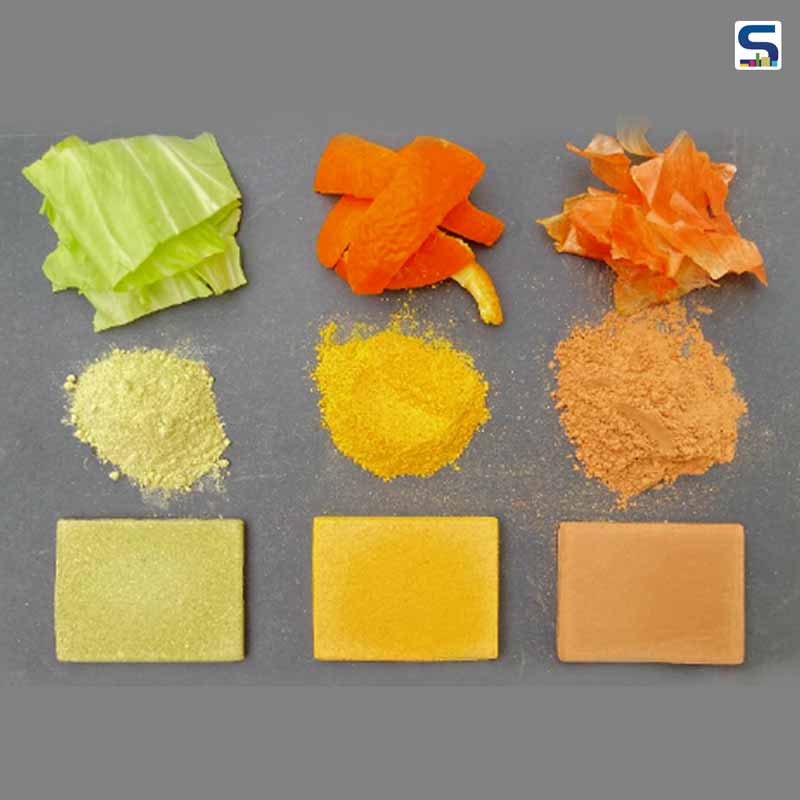
Having an edible house is no longer a distant dream as researchers from Institute of Industrial Science at The University of Tokyo have developed a new method to recycle food scrapes into robust construction materials. Learn more about this special material in this report by SURFACES REPORTER (SR).
From scrapes to material stronger than concrete
Worldwide industrial and household food waste amounts to hundreds of billions of pounds per year, a large proportion of which comprises edible scraps, like fruit and vegetable peels. This unsustainable practice is both costly and environmentally unfriendly, so researchers have been searching for new ways to recycle these organic materials into useful products.
"Our goal was to use seaweed and common food scraps to construct materials that were at least as strong as concrete," explains Yuya Sakai, the senior author of the study. "But since we were using edible food waste, we were also interested in determining whether the recycling process impacted the flavor of the original materials."

The Process
According to the research papre, 100% food waste materials including peels of oranges, onions, pumpkins, and bananas; the outer leaves of Chinese and other cabbages; and seaweed were used to conduct the experiment. To improve the taste and for reinforcement, salt, sugar, and natural edible clay were added. After cutting the raw materials into small pieces, they were placed in an oven set at a temperature of 105 °C or a vacuum drying machine for drying. The dried materials were pulverized using a blender or disk mill. The powder was mixed with water and seasonings and heat pressed under the respective forming conditions ranging 6?50 MPa and 60? 180 °C. The measured experimental conditions included the water content in weight, formingtemperature, pressure, and duration.
A three-point bending test was conducted to evaluate bending strength which proved to be as strong as the concrete and even more. "With the exception of the specimen derived from pumpkin, all of the materials exceeded our bending strength target," says Kota Machida, a senior collaborator. "We also found that Chinese cabbage leaves, which produced a material over three times stronger than concrete, could be mixed with the weaker pumpkin-based material to provide effective reinforcement."
As far as the application of this material is concerned, Yuya Sakai commented, "Some companies are interested in producing furniture, trays, boxes, etc. These products can be produced already if there is a heat-pressing machine and a set of mold to produce it. Our final goal is to build a house using this material."
Can Eat it too!
The new material thus created, retains its edible properties and a slight addition of salt or sugar can improve its taste while having no effect on its strength, the researchers claim. They also state that the resultant product is free from the threats of rot, fungi, and insects, and experienced no appreciable changes in appearance or taste after exposure to air for four months.
Given that food waste is a global financial burden and environmental concern, it is crucial to develop methods for recycling food scraps. Using these substances to prepare materials that are strong enough for construction projects, but also maintain their edible nature and taste, opens the door to a wide range of creative applications from the one technology.
Keep reading SURFACES REPORTER for more such articles and stories.
Join us in SOCIAL MEDIA to stay updated
SR FACEBOOK | SR LINKEDIN | SR INSTAGRAM | SR YOUTUBE
Further, Subscribe to our magazine | Sign Up for the FREE Surfaces Reporter Magazine Newsletter
Also, check out Surfaces Reporter’s encouraging, exciting and educational WEBINARS here.
You may also like to read about:
Rechargeable Concrete Batteries; a giant leap for clean energy | Chalmers University of Technology | Sweden | SR Material Innovation
Studio Mortazavi Designs Worlds First 3D Printed School in Madagascar | Thinking Huts
The First 3D Printed House ‘Gaia’ Built With Soil, Rice Husks, and Straws
Scientists at GE Research 3D Printed A Portable Device That Produces Water Out Of Thin Air
Butterfly-Shaped Residence Designed by 314 Architecture Studio in Greece
And more…